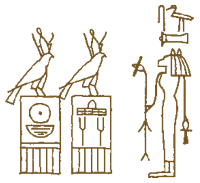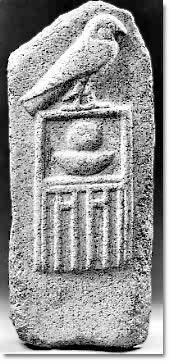If little was known about Hotepsekhemwi and his reign, even less is known about his successor, Nebre. That Nebre was indeed Hotepsekhemwi’s successor, is shown by several sources.

The Horus names of Hotepsekhemwi and Nebre standing before the earliest known depiction of the goddess Bastet.
Source: Wikipedia
Seal impressions bearing Nebre’s name in a tomb where Hotepsekhemwi’s name also occurs, either point to Nebre having taken care of the burial of Hotepsekhemwi or to Nebre usurping that tomb. A statue of a priest named Hotepdief lists the names of Hotepsekhemwi, Nebre and Ninetjer. Although this statue lists the funerary cults for which Hotepdief was responsible, it is often seen as a confirmation of the succession of the first three kings of the 2nd Dynasty as well.
An inscription on a stone bowl shows the names of Hotepsekhemwi and Nebre in front of the goddess Bastet. This source not even may confirm the succession order between the two kings, the fact that they are shown together may perhaps also point towards a co-regency between the two of them.
The relationship between Nebre and his successor is not known, nor are the names of any wives he may have had. If Gallery B at Saqqara belonged to Nebre rather than to his predecessor, Perneb, a “son of the king” and priest of Sopdu, may have been Nebre’s son.
The number of years credited to Nebre is missing in the Turin King-List, but Manetho grants him a rather unlikely 39 years. The fragments of the Annals Stone do not mention Nebre, but from a reconstruction of that stone, it has been deduced that the total number of years of the reigns of Hotepsekhemwi and Nebre would have been 39 years. Granting the former some 25 years, Nebre would have reigned about 14 years.
During his reign, Nebre did not leave many traces. His name suggests that the cult of the solar god Re was on the rise, perhaps an evolution of the solar god Netjer-Akhti who became important during the reign of Hotepsekhemwi.
Most surviving documents from his reign refer to the usual cultic and administrative activities and offer us little insight into Nebre’s policies.
It is not certain where Nebre was buried. That he had a funerary cult at Saqqara is shown by the statue of Bedjaw, but no tomb has been definitely identified. Unless he combined his own funerary cult with that of his predecessor, speculation that he usurped Hotepsekhemwi’s tomb may be contradicted by the statue of Bedjaw, which lists three funerary cults and not two.
